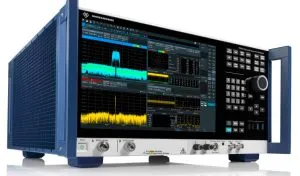The company emphasises a novel multi-path architecture that supports a cross-correlation mode, explaining:
A single signal input is internally split into two independent signal paths, each equipped with its own local oscillator and ADC. With this design, cross-correlation algorithms can be applied in the digital back-end, effectively removing the inherent noise of the measurement instrument. This feature reveals spurs not easily seen without cross-correlation. It is especially helpful when, for instance, measuring EVM [error vector magnitude]. [Electronics Weekly has requested a diagram]
The multi-path architecture also offers advanced triggering options. For example, users can apply an IF or RF power trigger at distinct frequencies, as the multi-path design allows for independent frequency settings for each receive path behind the splitter. This way, the FSWX an easily reveal effects between two RF signals.
The company also emphasised the multiple inputs more than once, without saying how many.
Exhaustive delving reveals the answer to be: two inputs, with models at either 26.5 or 44GHz bandwidth.
“With synchronous input ports, each featuring 4GHz analysis bandwidth, users can analyze the interactions between diverse signals,” said R&S “This opens up new measurement scenarios, for instance, phase-coherent measurements of antenna arrays used in beam-forming.”
There are also conventional one-input FSWX models, again with a choice of 26.5 or 44GHz bandwidth.
Internal bandwidth is 8GHz, aided by avoiding YIG pre-selection filters and adopting broadband ADCs in conjunction with filter banks that “span the entire operating frequency range, allowing for pre-selected signal analysis while eliminating the need for YIG filters”, it said. “For users requiring narrowband applications, a YIG filter can still be added optionally.”
Firmware is available for ‘cross application control and triggering’ (CrossACT) which synchronises measurements across different input channels allowing for simultaneous analysis with multiple tools. “This capability simplifies comparisons, such as determining whether the higher harmonics of a radar signal directly impact the error vector magnitude performance of a 5G signal,” said R&S.
See FSWX spectrum analysers at the Moscone Center on stand 1,443 from 17 to 19 June, or look at this R&S web page.
In April, Siglent revealed a multi-instrument mobile 5G signal analyser for 5G NR/LTE with 9kHz to 7.5GHz range and 110MHz real-time analysis bandwidth.

